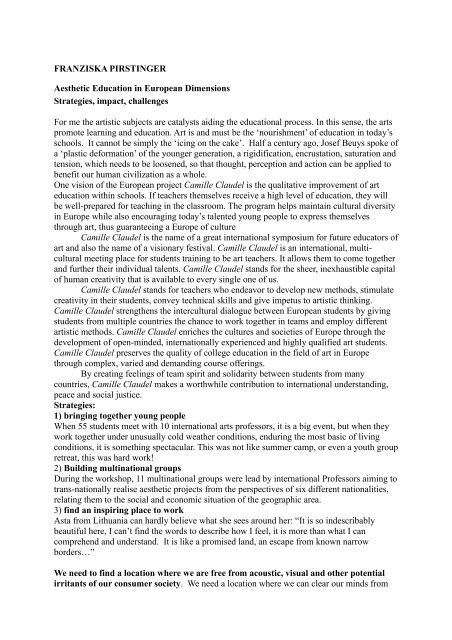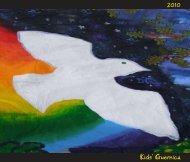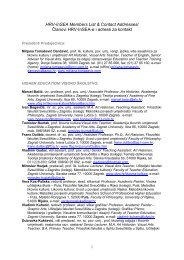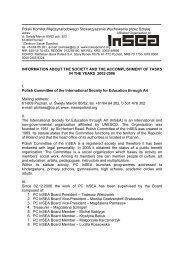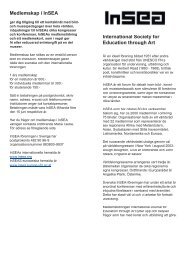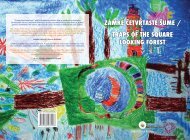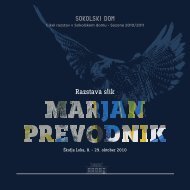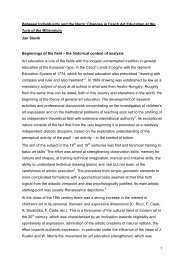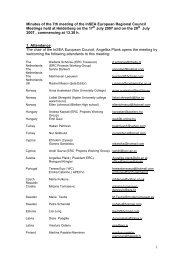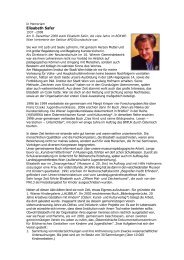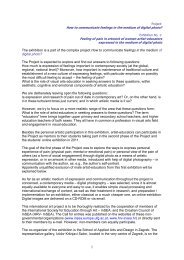FRANZISKA PIRSTINGER - InSEA Europe
FRANZISKA PIRSTINGER - InSEA Europe
FRANZISKA PIRSTINGER - InSEA Europe
You also want an ePaper? Increase the reach of your titles
YUMPU automatically turns print PDFs into web optimized ePapers that Google loves.
<strong>FRANZISKA</strong> <strong>PIRSTINGER</strong><br />
Aesthetic Education in <strong>Europe</strong>an Dimensions<br />
Strategies, impact, challenges<br />
For me the artistic subjects are catalysts aiding the educational process. In this sense, the arts<br />
promote learning and education. Art is and must be the ‘nourishment’ of education in today’s<br />
schools. It cannot be simply the ‘icing on the cake’. Half a century ago, Josef Beuys spoke of<br />
a ‘plastic deformation’ of the younger generation, a rigidification, encrustation, saturation and<br />
tension, which needs to be loosened, so that thought, perception and action can be applied to<br />
benefit our human civilization as a whole.<br />
One vision of the <strong>Europe</strong>an project Camille Claudel is the qualitative improvement of art<br />
education within schools. If teachers themselves receive a high level of education, they will<br />
be well-prepared for teaching in the classroom. The program helps maintain cultural diversity<br />
in <strong>Europe</strong> while also encouraging today’s talented young people to express themselves<br />
through art, thus guaranteeing a <strong>Europe</strong> of culture<br />
Camille Claudel is the name of a great international symposium for future educators of<br />
art and also the name of a visionary festival. Camille Claudel is an international, multicultural<br />
meeting place for students training to be art teachers. It allows them to come together<br />
and further their individual talents. Camille Claudel stands for the sheer, inexhaustible capital<br />
of human creativity that is available to every single one of us.<br />
Camille Claudel stands for teachers who endeavor to develop new methods, stimulate<br />
creativity in their students, convey technical skills and give impetus to artistic thinking.<br />
Camille Claudel strengthens the intercultural dialogue between <strong>Europe</strong>an students by giving<br />
students from multiple countries the chance to work together in teams and employ different<br />
artistic methods. Camille Claudel enriches the cultures and societies of <strong>Europe</strong> through the<br />
development of open-minded, internationally experienced and highly qualified art students.<br />
Camille Claudel preserves the quality of college education in the field of art in <strong>Europe</strong><br />
through complex, varied and demanding course offerings.<br />
By creating feelings of team spirit and solidarity between students from many<br />
countries, Camille Claudel makes a worthwhile contribution to international understanding,<br />
peace and social justice.<br />
Strategies:<br />
1) bringing together young people<br />
When 55 students meet with 10 international arts professors, it is a big event, but when they<br />
work together under unusually cold weather conditions, enduring the most basic of living<br />
conditions, it is something spectacular. This was not like summer camp, or even a youth group<br />
retreat, this was hard work!<br />
2) Building multinational groups<br />
During the workshop, 11 multinational groups were lead by international Professors aiming to<br />
trans-nationally realise aesthetic projects from the perspectives of six different nationalities,<br />
relating them to the social and economic situation of the geographic area.<br />
3) find an inspiring place to work<br />
Asta from Lithuania can hardly believe what she sees around her: “It is so indescribably<br />
beautiful here, I can’t find the words to describe how I feel, it is more than what I can<br />
comprehend and understand. It is like a promised land, an escape from known narrow<br />
borders…”<br />
We need to find a location where we are free from acoustic, visual and other potential<br />
irritants of our consumer society. We need a location where we can clear our minds from
the mental chitter-chatter that tends to lead us in our decision making process. At our chosen<br />
location we experience `deceleration`, learn to recognise a long forgotten ‘slow pace’, and<br />
become aware of a deprivation of outside stimulus, which all becomes a luxury to us.<br />
When one spends 14 days living a humble existence in nature, one confronts his/her own<br />
powerlessness and the fascinating invincibility and beauty of nature.<br />
4) Sensitisation of Perception<br />
For the team of professors, the first goal is concentrate on the senses –to instill sensory<br />
perception into consciousness. To walk barefoot on a lawn dampened lightly with dew, to lay<br />
your bare body on the soil in the fields or on the hot sand in the quarry, to climb over sharp<br />
rocky cliffs or walk through thorny bush, to enjoy the sunrise over the lake Neusiedl near the<br />
quarry, or to catch the suns rays as they dance in the high grass on the fields, or from those<br />
that are reflected from the many sandstone sculptures throughout the hills… First we have to<br />
get rid of any internal conflicts as we are not aware of societies influence on us, and how rash<br />
and half-heartedly we seek to find solutions.In an interplay between thinking and feeling –<br />
between using the body and the mind, and through intensive reflection of all that is<br />
happening, and all that we do, we learn to be creative. When we work in groups we see that<br />
creativity is not simply a psychological, but rather a social experience. It is not something<br />
that we can pull out of a filing cabinet, but rather something we find in our personal<br />
interaction with others.<br />
5) Endurance and expertise<br />
One of the main challenges for Professors during an extended project is to awake the students’<br />
passion for artistic tasks. They must learn to work for the pure pleasure of creating, to use the<br />
technical term – intrinsic motivation Most people don’t fail by seeking the solutions to the<br />
problems but because they give-up to soon.<br />
Without having ‘bashed in our brains’ and having felt complete physical exhaustion, we<br />
would not have reached this point of awareness.<br />
“Rock hard and almost unconquerable, I approached my small bolder. Will I be able to chisel<br />
my idea of what this bolder should become, with only this ancient iron tool of antique<br />
creation – or will this rock change my idea, change me - Tears are shed and pain felt after<br />
one solid week of hard work, then finally a sculpture is visible – a communication between the<br />
stone and my perseverance and ability.” Anna/Sweden<br />
6) Flow Experience:<br />
When the skills of the students and the task to fulfil form an integrated whole, the result will<br />
be a flow-experience. The student attention will be fully concentrated on completing the task<br />
at hand. We see that the attentive students` perception of time has diminished and they were<br />
so fully concentrated that they didn’t respond to any interruptions. In this state, we are totally<br />
involved with what we are doing and fully concentrated. This is a time of high motivation<br />
and a strong willingness to perform.<br />
7) Practice of techniques:<br />
.The beginning of creativity is the handicraft – without the technical know-how to execute the<br />
techniques of etching, painting or sculpture that the professors fanatically try to communicate,<br />
students would certainly not be able to produce such successful graphics, paintings and<br />
sculptures. Without learning the fundamentals, even a promising talent could not succeed. On<br />
the other hand, with adequate training involving the technical skills, even a mediocre student<br />
can produce astonishing works showing a great deal of creativity.<br />
8) Ask the right questions:<br />
The professors do not provide students with answers to problems; they try to stimulate the<br />
students into asking themselves the ‘right’ questions. Art and creativity connects the known<br />
with the unknown, making the boarder between that which is conscious and that which is
unconscious, transparent. It awakens a persons curiosity, allowing them to explore areas that<br />
were previously unknown to them.<br />
10) Products:<br />
We tried to artistically realise, what we authentically experienced, rather than copy something<br />
we already knew. To do this, we had to break with known norms. We did not concentrate on<br />
any particular norm of beauty, or the production of a piece of artwork, but rather on reflecting<br />
on what skills we already had, while venturing into new experiences. When confronting these<br />
new experiences, we sometimes experienced frustration, exhaustion and the possibility of<br />
failure.<br />
11) Teachers expertise:<br />
Teachers tried to steer students away from quickly trying to achieve a preconceived notion of<br />
producing the perfect artwork using known methods. We tried to show them how to take a<br />
slower path towards reaching their goals. We did not protect the students from the possibility<br />
of failure or hard work, but rather encouraged them to find a way to authentically express<br />
themselves.<br />
Whether or not a picture was painted on a traditional canvas, on the body, or scratched onto a<br />
copperplate, or printed on the computer or an object was made from felt, or the wind was<br />
allowed to finish a painting or blow it away; we experienced different forms of expression<br />
which were individual and representative to the international reactions to a theme. In contrast<br />
to that first traditional sculpture symposium back in 1958, the students expressed sculpture in<br />
the form of performance, installation and contemporary land art. The art educators saw<br />
themselves as guides along the path of discovery between the artists’ view of the world and<br />
the forming of students’ aesthetic experiences.<br />
Challenges and impact:<br />
This process was often exhausting, both for teachers and students, as it went beyond the<br />
expression of our normal artistic capabilities. Artistic creativity is not a by-product of any<br />
experiment, or the result of chance; it is the consequence of a particular kind of attention that,<br />
reflects on itself, and its authenticity and intensity.<br />
The problem of speaking different languages was very big, but hardly a deterrent. A special<br />
kind of ‘prototype English slang’ energed, which accompanied the language of the eyes,<br />
laugh, good humour and actions of the individuals, including an extraordinary amount of<br />
picture and sign language, which everyone used to communicate parallel to verbal<br />
communication. In this way, we were able to express the unspeakable.<br />
Challenge and impact of this program can be best expressed in student coments:<br />
During this symposium we learned the real value of the Euro is not how many Euros you or I<br />
have, but that what we have, we exchange equally for mutual benefit. By exchanging our<br />
ideas, we increased the value of what we had before by 100%. We also realised that by<br />
exchanging our ideas, we help to positively improve the world. “I couldn’t believe how<br />
different the people of <strong>Europe</strong> were – but I realised that we all have the same wish - to make<br />
the world a better and more positive place to live in. We saw that it is long way to ‘<strong>Europe</strong>’,<br />
but at least together; we took a step towards a <strong>Europe</strong>an vision. The professors started a fire<br />
in the hearts of the youth here this week – and it will not be extinguished.”<br />
Claudia, a student from Belgium, completed a piece of artwork at the top of a cliff. It was a<br />
long process that included fear, exhaustion and enduring extremes in the weather, which<br />
nearly made her give up altogether. Somehow she found the strength to succeed: “Now I<br />
know who I am and what strength is inside of me. I know that in the future, when I realise<br />
how important something is to me, that I can give it more to achieve my goal. I reached a<br />
milestone with this and I will value it for the rest of my life. In the future I will not give in so<br />
easily when trying to achieve my goals.”
We can describe the attitude of these <strong>Europe</strong>an students as young, dynamic and optimistic.<br />
After two years students are still contacting us and describing the deep impact on their<br />
personal development. Many students met new friends and found their artistic break through.<br />
Each one learned their own personal lessons about what creativity is, and how much<br />
individual potential each one has in reaching it, and in using it responsibly to shape the world.


